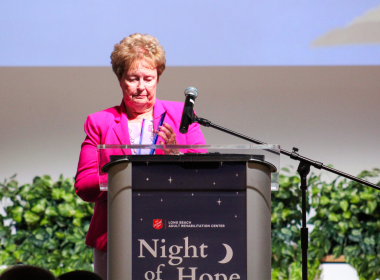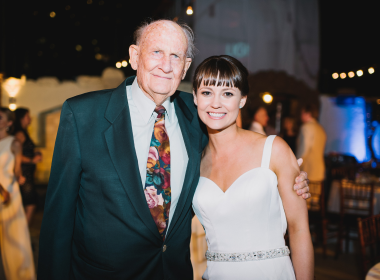 A TEACHER and student discuss goals and plan a course of study that will help the student in pursuing a G.E.D. |
STORY & PHOTOS BY TANYA WILLIAMS –
WHEN WILLIAM BOOTH founded The Salvation Army in 1865, he discovered that he could not save men’s souls without first filling their bellies. On this premise, The Salvation Army was born and continues today. Meeting human needs, he knew, must precede spiritual, physical and intellectual direction.
Programs like The Salvation Army Greenhouse Center, Harbor Light Center and West Women’s and Children’s Shelter live this mission. Together, they serve more than 1,500 homeless individuals in the Portland area each year through their programs and services. The following stories exemplify the depth and breadth of the challenges homeless children face in schooling and education, and illustrate what The Salvation Army is doing to help them and others overcome their situations and succeed in school.
* * *
(Ed. note: “Angela” is a fictional creation, and is a composite of a number of students helped at the center, reflecting a variety of needs that are met in a caring and effective way.)
Nine-year old Angela was in third grade when her family was evicted from its North Portland apartment. As they moved from homeless shelter to homeless shelter, Angela was forced to change schools. Unable to keep up with her schoolwork and increasingly distracted in class, Angela’s grades slipped dramatically. Her classmates made fun of her. Her parents could no longer help her practice spelling after school, much less go over homework, and her new teacher simply didn’t have time to give her the one-on-one help she needed. Angela was falling through the cracks.
Fortunately, her family made their way to Harbor Light Center. There, Angela found an after-school program called Project Return sponsored by Portland Public Schools. For ten years, Project Return has teamed up with Harbor Light and other Portland-area shelters to provide homeless children with school supplies and clothes and access to computers via a mobile classroom called the computer bus. Recently, Project Return placed a study corner in the family day room at Harbor Light. Staffed by a paid teaching assistant four days a week, the study corner provides one-on-one tutoring and help with homework for grade school students, like Angela, who reside at Harbor Light.
“Project Return has given the children a place to meet and share what they’ve learned at school, and in doing so, learn from each other,” says Major Neal Hogan, director of Harbor Light. The project also helps families by providing transportation to and from school, allowing homeless children to stay in the same school, even though their families may move from shelter to shelter. Last year, Project Return served 60 students at Harbor Light, and even more are expected this year. Together, Harbor Light and Project Return have provided the safe, nurturing environment that students like Angela need to succeed in school while their families are in transition.
* * *
When Danny’s mother beat him the afternoon of his 16th birthday, Danny left home for good and quit school shortly thereafter. With only a tenth-grade education, Danny couldn’t find work and eventually wound up at Greenhouse. He was interested in pursuing his G.E.D., but he wasn’t looking forward to returning to the classroom. The Salvation Army Greenhouse Alternative School turned out to be just the educational environment he was looking for. A drop-in program, the alternative school is open 9 a.m. to 2 p.m., five days a week. Danny was assessed and given an individual curriculum based on his previous education and current abilities.
The alternative school is anything but a traditional classroom. The teacher is more likely to be with an individual student at a table than standing at the front of the room as a matter of fact, there is no “front” of the room. Learning is student-paced and often, student-directed. Here, teachers are far more than educators, and lessons are not confined to the classroom.
“You can’t do fractions if you don’t have food,” says Beth Burns, a teacher at Greenhouse Alternative School, “so we always have food around.” Her role, she says, is to provide a safe place for youth, like Danny, to explore education, and to be empowered by it. Often, that means that she listens more than she talks and facilitates more than she teaches. Through grants, Greenhouse is able to provide field trips to the ballet, the Portland Art Museum, the theater, even rock and roll concerts. This summer, they are even planning an excursion to Ashland for the Shakespeare Festival.
In the last two years, 49 Greenhouse students, including Danny, have received their G.E.D.s. “It’s more than building their self-esteem,” she says, “it’s about self-respect and self-image. They need to feel that they belong to this community; they need to be heard.”
* * *
When Rachel and her mom arrived at West Women’s and Children’s Shelter, 13-year old Rachel was suffering from a severe anxiety disorder. She had bounced around homes of relatives and moved from boyfriend to boyfriend with her mom. This combination of continual displacement and the trauma of living in a domestic violence situation made social interaction almost impossible for Rachel. Her self-confidence was shot, her grades were slipping and she was slowly withdrawing from society. Without money for private schooling, Rachel was forced to stay in the public school where other students were often cruel and teachers frequently mistook her quiet, insecure demeanor for apathy.
Rachel entered the children’s program at The West and began meeting regularly with a therapist and getting regular help with her schoolwork. But Rachel was still struggling. Her anxiety was extreme, and it became clear to her caseworker and to shelter director, Pat Mohr, that she needed to be placed in a special school. Working together, the staff of West Women’s fought to get Rachel into Thomas Edison High School, a private school for uniquely challenged students.
Child advocacy is but one element of the children’s program at West Women’s. The 11-hour a day program also provides therapeutic child-care in a flexible environment. The advocates meet regularly with moms to discuss children’s medical, educational and therapeutic needs and provide them with parenting tools and necessities like diapers, books and educational toys. In addition, the program organizes activities and field trips to parks, museums, the zoo and even to KMart for Christmas gifts. The West also recruits tutors for students with special needs and works with Project Return to provide a homework club twice a week at the shelter. As a result of the shelter’s many efforts on her behalf, Rachel is now a sophomore at Thomas Edison High School where she is getting all A’s and B’s.
* * *
Angela, Danny and Rachel are but three examples of the many challenges homeless youth and families face regarding schooling and education. These challenges are not theirs alone, they are ours. The battle is far from won and yet, there is promise, there is hope. Meeting the needs of individuals, especially children, in our communities allows us to strengthen them, one life at a time.










